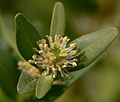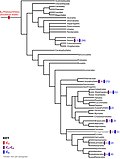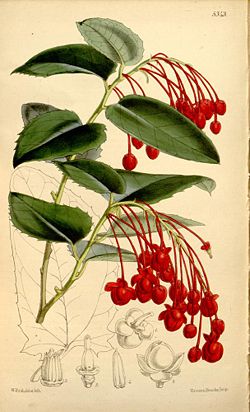Apodanthaceae and Gumillea, remained unplaced in APG III. Five taxa were unplaced among the angiosperms in APG III because Nicobariodendron and Petenaea...
30 KB (3,225 words) - 22:26, 27 May 2025
families unplaced as to order, although contained in supra-ordinal clades, in the APG system. APG II recognized 457 families, five fewer than the APG system...
7 KB (651 words) - 08:44, 20 October 2024
been unplaced in APG II. Nicobariodendron and Petenaea were newly added to the list. The latter was later placed into its own family Petenaeaceae in the...
47 KB (3,194 words) - 23:22, 30 November 2024
Angiosperm Phylogeny Group (APG II) both families are unplaced to order, but nevertheless included in the Eurosids I. The APG III system of 2009, however...
5 KB (334 words) - 16:16, 7 September 2024
Angiosperm Phylogeny Group (APG) does not recognize the order, initially leaving the family Illiciaceae unplaced as to order. In its second higher level taxonomy...
3 KB (317 words) - 04:34, 8 April 2024
unplaced as to order, but was assigned to this same clade (although APG used the spelling "commelinoids"). The family contains almost 400 species in five...
4 KB (363 words) - 03:43, 20 July 2025
and Aextoxicaceae. However, APG II left the families unplaced as to order, assigning them to the clade core eudicots. The APG III system of 2009 formally...
2 KB (198 words) - 11:59, 20 June 2025
one family, Dilleniaceae. The APG III system of 2009, like the earlier APG II system of 2003, left the Dilleniaceae unplaced as to order, while noting that...
2 KB (168 words) - 20:11, 4 February 2025
Group (APG). It was published in 2016, seven years after its predecessor the APG III system was published in 2009, and 18 years after the first APG system...
40 KB (2,558 words) - 15:23, 27 July 2025
which firmly recognised both families as separate. In both APG and APG II, the family Buxaceae is unplaced as to order and left among the basal lineages of...
4 KB (375 words) - 17:30, 26 October 2023
Trimeniaceae (section APG II)
the most basal lineages in the clade angiosperms. The APG system, of 1998, also recognized this family, but left it unplaced as to order, and regarded...
4 KB (440 words) - 02:50, 8 April 2024
Angiosperm Phylogeny Group (category Scientific organizations established in 1998)
2016[update], three revisions have been published, in 2003 (APG II), in 2009 (APG III) and in 2016 (APG IV), each superseding the previous system. Thirteen...
33 KB (3,554 words) - 08:36, 21 June 2025
Illiciaceae. The APG IV and APG III systems of taxonomy recognize this family and place it on the order Austrobaileyales. The APG II system, of 2003,...
11 KB (601 words) - 15:31, 22 August 2024
130 species in eight genera. In the APG II system it is one of eight families in the euasterids II clade (campanulids) that are unplaced as to order....
3 KB (220 words) - 23:53, 22 December 2024
Rafflesiaceae The APG II system regards Rafflesiaceae as an unplaced family of three genera. Also unplaced is the genus Mitrastema. However, APG II does have...
990 bytes (94 words) - 22:52, 9 October 2022
In the APG III system of 2009, the family is placed in its own order, Paracryphiales, in the campanulid clade of the asterids. In the earlier APG II system...
3 KB (233 words) - 05:38, 8 April 2024
tree in the broadleaf forests. It can reach 15 m tall. The APG system (1998) and the APG II system (2003) left the family Aextoxicaceae unplaced in the...
6 KB (522 words) - 18:03, 1 July 2025
absolutely proven. The APG II system, of 2003 (unchanged from the APG system of 1998), also recognizes this family, unplaced as to order, assigned to...
7 KB (656 words) - 20:25, 24 May 2025
the clade monocots, unplaced as to order. The APG III system of 2009 and the APG IV system of 2016 placed the family Petrosaviaceae in the order Petrosaviales...
5 KB (400 words) - 02:00, 23 July 2025
family Flacourtiaceae. The APG II system, of 2003 (unchanged from the APG system, of 1998), does recognize this family, unplaced as to order and merely assigned...
2 KB (221 words) - 04:05, 8 April 2024
flowering plants. The APG II system (2003) treats the family in the order Liliales, in the clade monocots. This is a slight change from the APG system, of 1998...
5 KB (464 words) - 06:09, 1 July 2025
Didymelaceae were given their own order. In the APG II system of 2003, the Buxaceae were a family unplaced as to order in the eudicots, optionally including the...
9 KB (981 words) - 11:53, 20 June 2025
adopted. The APG II system does not recognize a group called "paleodicots" but assigns these early-diverging dicots to several orders and unplaced families:...
7 KB (655 words) - 21:02, 26 March 2025
represents a slight change from the APG system, 1998, which left the family unplaced as to order, but placed it in the same clade (although it used the...
3 KB (254 words) - 08:28, 21 June 2025
Dasypogonaceae (category All Wikipedia articles written in Australian English)
conflicting models, and leave it in an order of its own, the Dasypogonales. The earlier APG III (2009), APG II (2003), and the 1998 APG system all accepted the...
7 KB (616 words) - 16:52, 30 June 2025
order is used according to the APG III system. The order takes its name from the family Asparagaceae and is placed in the monocots. The order is clearly...
39 KB (4,304 words) - 03:10, 8 April 2024
Magnoliids (section APG system)
but agrees more closely with the circumscription later published under APG II.[citation needed] Comparison of classification systems is often difficult...
24 KB (2,444 words) - 15:01, 26 May 2025
Phylogeny Group classification for the orders and families of flowering plants: APG II". Botanical Journal of the Linnean Society. 141 (4): 399–436. doi:10.1046/j...
7 KB (590 words) - 17:29, 25 May 2025
as the sole family in the order Sabiales, or (as in the APG II system and APG III system), as unplaced to order and left among the basal lineages of the...
12 KB (1,216 words) - 10:02, 22 July 2025
the Hydrangeales by Takhtajan, but the APG II system placed it in the Euasterids II clade (campanulids) unplaced as to order. More recent work has provided...
2 KB (130 words) - 22:46, 24 April 2025
























